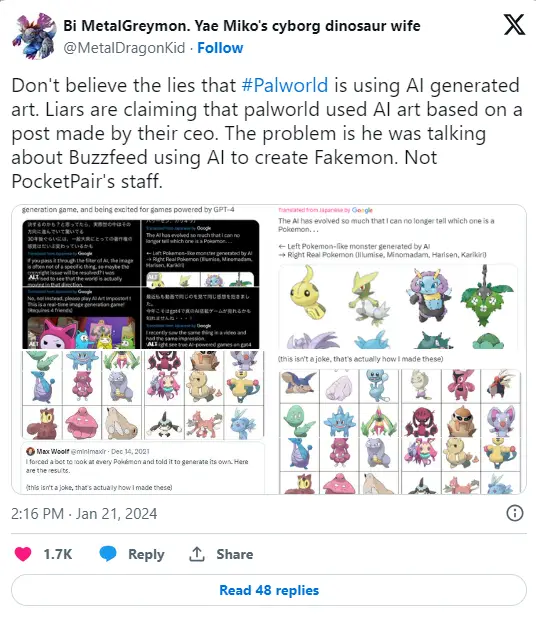Palworld CEO's Tweets Lead to AI-Generated Content Controversy

In the ever-evolving landscape of video game development, the emergence of artificial intelligence AI tools has sparked a revolution, bringing both unparalleled opportunities and complex ethical dilemmas. The recent controversy surrounding Palworld, a game developed by Pocketpair, exemplifies this new frontier. Allegations that CEO Takuro Mizobe’s old tweets hinted at the use of AI to generate the game’s creatures, known as Pals, have stirred a significant debate within the gaming community. This situation not only highlights the innovative use of AI in game design but also raises critical questions about the fine line between inspiration and plagiarism, the ethical use of AI, and the need for transparency in the creative process.
The Palworld controversy, stemming from claims about AI-generated content, reflects the broader challenges and opportunities presented by AI in game development.
Table of Contents
What is Palworld?
Palworld is a unique and ambitious game developed by Pocketpair, blending elements of adventure, creature collection, and survival in a vibrant open-world setting. The game stands out for its innovative approach to gameplay, combining the thrill of exploring vast landscapes with the excitement of discovering and capturing over 100 different “Pals” – creatures each with their own unique abilities and characteristics. These Pals are central to the game’s experience, offering players a wide range of interactions, from battling to building. Palworld’s rich and diverse environment promises an engaging experience for players, with its seamless integration of various gameplay elements like monster capturing, combat, and base building.
What sets Palworld apart is its intricate blend of gameplay mechanics. Players can engage in battles using a variety of weapons, from traditional bows to modern firearms, and capture Pals by strategically throwing spheres at them. The game also introduces survival elements, requiring players to gather resources and craft items for sustenance. Additionally, Palworld offers a multiplayer experience, allowing players to either cooperate or compete with each other in its expansive world. This multiplayer aspect adds a dynamic layer to the game, fostering a community-driven environment. The game’s unique features, combined with its open-world exploration and creature interaction, make Palworld a distinctive addition to the gaming landscape.
Also read:Palworld Controversy: Between Innovation and Imitation

Palworld's CEO Takuro Mizobe's Old Tweets
The Emergence of the Controversy
The gaming community was stirred when old tweets from Takuro Mizobe, the CEO of Pocketpair, the company behind Palworld, resurfaced and sparked a heated debate. In these tweets, Mizobe hinted at the use of artificial intelligence (AI) in creating creatures within the game, leading to speculation and concern among players. The tweets, dating back to 2021, suggested a fascination with AI’s potential to generate Pokémon-like creatures while skirting copyright issues. This revelation brought to light questions about the originality and authenticity of the game’s content, particularly the Pals, which are central to the game’s appeal.
Players’ Interpretation and Reaction
Players and critics quickly jumped on these tweets, interpreting them as an admission that Palworld’s Pals might be AI-generated, raising concerns about plagiarism and originality in game design. Side-by-side comparisons of Pals with various Pokémon were circulated on social media, intensifying the allegations. The community’s reaction was a mix of disappointment and curiosity, with many expressing concern over the ethical implications of using AI in this manner. While some players were intrigued by the technological feat, others felt betrayed, believing that the game they cherished might not be as original as they had thought. This controversy placed Palworld at the center of a broader discussion about the role of AI in creative processes and the fine line between inspiration and outright copying in the gaming industry.
Palworld Developer Claims 100+ Pals are Original, Not AI Generated
Developer’s Response to AI Allegations
In response to the controversy surrounding the use of AI in creating Pals, the developers of Palworld, led by CEO Takuro Mizobe, have firmly stated that over 100 Pals in the game are original creations and not products of AI generation. This assertion came as a direct counter to the claims made by players and critics based on Mizobe’s old tweets. The development team emphasized their commitment to originality and creativity in the game’s design, highlighting the extensive work and imagination that went into crafting each unique Pal. They stressed that while AI technologies are prevalent in many industries, the Pals in Palworld are the result of human creativity and artistic endeavor, not AI algorithms.
Impact of the Statement on the Gaming Community
The developer’s statement aimed to reassure players and stakeholders about the authenticity and originality of the game’s content. This clarification was crucial in addressing the growing concerns over intellectual property rights and ethical game design practices. The gaming community’s reaction to this clarification was mixed. Some players expressed relief and continued support for the game, appreciating the developers’ commitment to original content. Others remained skeptical, calling for more transparency and evidence to support these claims. This situation highlighted the challenges faced by game developers in the era of AI and the importance of maintaining trust and authenticity in the gaming industry.

Key Features of Palworld
Palworld is a unique and captivating game that has garnered attention for its innovative blend of various gameplay elements.
Gameplay Mechanics
Palworld offers a rich and diverse gameplay experience that combines elements of monster capturing, battle, and survival. Players can explore a vast world filled with over 100 unique Pals, each possessing distinct abilities and characteristics. The game seamlessly integrates these aspects:
- Monster Capturing: Players can capture Pals using a strategic sphere-throwing technique, with success rates increasing when the Pal is weakened.
- Combat System: The game features a variety of weapons, from traditional bows to modern firearms, allowing for diverse combat strategies.
- Survival Elements: Players must navigate the challenges of the game’s world, including resource gathering and crafting for survival.
Multiplayer Experience
One of the most exciting aspects of Palworld is its multiplayer functionality. Players can join forces or compete against each other in an expansive open world. This feature adds a dynamic layer to the gameplay:
- Cooperative Play: Team up with friends to explore the world, capture Pals, and build bases together.
- Competitive Battles: Engage in thrilling battles against other players, showcasing the strength and skills of your Pals.
- Resource and Item Trading: Players can trade resources and items with each other, adding an economic aspect to the game.
Unique Elements of Palworld
Palworld is not just about battles and survival; it also offers unique elements that set it apart from other games in the genre:
- Base Building: Players can construct and customize their bases, creating a personal space in the game world.
- Pal Assignments: Assign Pals to various tasks like item collection, farming, and electricity generation, each working based on its personality.
- Environmental Interaction: The game world reacts and changes based on player actions, providing a dynamic and immersive experience.
The Community's Reaction to the AI Controversy
Skepticism and Disappointment
The revelation of CEO Takuro Mizobe’s old tweets and the subsequent AI controversy elicited a wave of skepticism and disappointment within the Palworld community. Many players felt betrayed, questioning the originality of the Pals they had come to enjoy. Forums and social media platforms were abuzz with discussions, as players debated the ethical implications of using AI in game development. This skepticism was not just about the potential use of AI, but also about the transparency and honesty of the developers in communicating with their player base.
Curiosity and Technological Fascination
Conversely, a segment of the community expressed curiosity and fascination with the idea of AI-generated content. Tech enthusiasts and some gamers saw this as a groundbreaking use of AI in creative processes, potentially heralding a new era in game development. These individuals were less concerned with the controversy and more interested in the technological capabilities and future possibilities that AI integration in gaming could bring. This group viewed the controversy as an opportunity to explore and discuss the evolving role of AI in the creative industry.
Calls for Transparency and Ethical Practices
A significant portion of the community called for greater transparency from the developers and a commitment to ethical practices in game design. This group advocated for clear communication about the use of AI and its impact on the game’s content. They emphasized the importance of respecting intellectual property rights and maintaining the integrity of the gaming experience. This reaction highlighted a growing demand for ethical considerations in game development, especially in an era where technology like AI is becoming increasingly prevalent.

The Role of AI in Modern Game Development
Enhancing Creativity and Efficiency
AI technology is increasingly being recognized for its potential to enhance creativity and efficiency in game development. AI can automate mundane tasks, allowing developers to focus on more creative aspects of game design. It can also generate complex environments and character models, speeding up the development process. This integration of AI is seen as a tool to augment human creativity, not replace it, enabling developers to push the boundaries of what’s possible in game creation.
Personalizing Player Experiences
AI is playing a crucial role in personalizing gaming experiences. By analyzing player behavior and preferences, AI can adjust game difficulty, suggest content, or even alter storylines in real-time, creating a more engaging and tailored experience for each player. This adaptive technology is transforming how players interact with games, making them more immersive and responsive to individual play styles.
Ethical and Technical Challenges
The integration of AI in game development also brings ethical and technical challenges. Concerns about data privacy, potential biases in AI algorithms, and the impact on job security in the industry are prevalent. Additionally, the complexity of AI systems requires significant resources and expertise, posing challenges for smaller development teams. Navigating these challenges is crucial for the responsible and effective use of AI in gaming.
The Fine Line Between Inspiration and Plagiarism
Recognizing Originality in Game Design
In the gaming industry, distinguishing between inspiration and plagiarism is a delicate balance. While it’s common for developers to draw inspiration from existing games, there’s a fine line between homage and copying. Recognizing originality involves respecting the intellectual property of others while creating something new and unique. This balance is crucial for fostering creativity and innovation in the industry.
The Impact of AI on Creative Processes
With the advent of AI, the line between inspiration and plagiarism becomes even more blurred. AI can generate content that closely resembles existing works, raising questions about the originality of such creations. Developers must ensure that AI-generated content is used responsibly, avoiding the infringement of existing intellectual property and maintaining the integrity of their creations.
Legal and Ethical Considerations
The controversy surrounding Palworld underscores the legal and ethical considerations in game development. Developers must navigate copyright laws and ethical standards to ensure that their games are both legally compliant and morally sound. This includes being transparent about the use of AI and respecting the original works that may have inspired their creations. The industry’s response to these challenges will shape the future of game development and the role of AI within it.
Conclusion
The Palworld controversy, ignited by CEO Takuro Mizobe’s old tweets, has opened a Pandora’s box in the gaming industry, revealing the complex interplay between AI technology and creative integrity. While the developers of Palworld have asserted the originality of their Pals, the community’s reaction has been a mosaic of skepticism, curiosity, and calls for ethical transparency. This situation underscores the evolving role of AI in game development, highlighting its potential to enhance creativity and personalize experiences, but also its capacity to blur the lines between inspiration and plagiarism. As we navigate this new era, the Palworld case serves as a crucial reminder of the importance of balancing technological innovation with ethical responsibility, ensuring that the heart of gaming remains human creativity and imagination.

